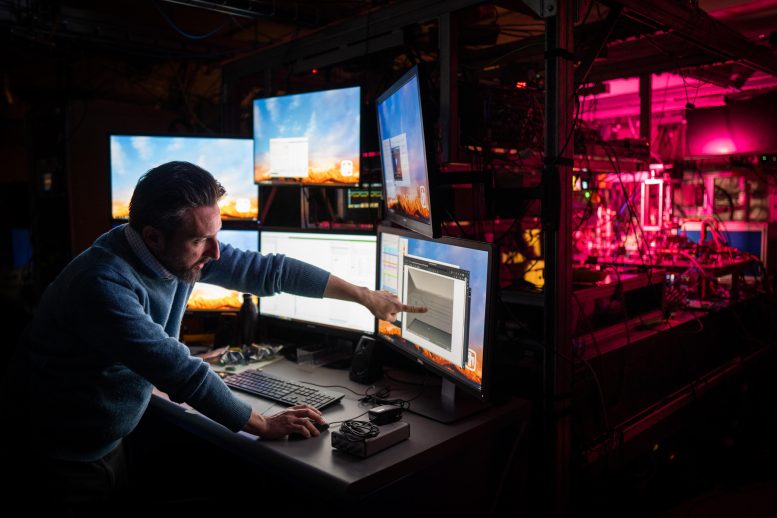Sandia Labs manufactures its first devices capable of supporting 200 trapped ion qubits.
Sandia National Laboratories has produced its first lot of a new world-class ion trap, a central component for certain quantum computers. This innovative device, termed the Enchilada Trap, enables researchers to construct more powerful machines, propelling the experimental yet groundbreaking realm of quantum computing forward.
In addition to traps operated at Sandia, several traps will be used at Duke University for performing quantum algorithms. Duke and Sandia are research partners through the Quantum Systems Accelerator, one of five U.S. National Quantum Information Science Research Centers funded by the Department of Energy's Office of Science.
An ion trap is a type of microchip that holds electrically charged atoms, or ions. With more trapped ions, or qubits, a quantum computer can run more complex algorithms.

Jonathan Sterk points to the section of an ion trap trapped ion qubits travel in a close-up view of the trap inside a vacuum chamber at Sandia National Laboratories. Credit: Craig Fritz, Sandia National Laboratories
With sufficient control hardware, the Enchilada Trap could store and transport up to 200 qubits using a network of five trapping zones inspired by its predecessor, the Roadrunner Trap. Both versions are produced at Sandia's Microsystems Engineering, Science, and Applications fabrication facility.
According to Daniel Stick, a Sandia scientist and leading researcher with the Quantum Systems Accelerator, a quantum computer with up to 200 qubits and current error rates will not outperform a conventional computer for solving useful problems. However, it will enable researchers to test an architecture with many qubits that in the future will support more sophisticated quantum algorithms for physics, chemistry, data science, materials science, and other areas.
"We are providing the field of quantum computing room to grow and explore larger machines and more complicated programming," Stick said.
Sandia National Laboratories electrical engineer Ray Haltli optimizes parameters before placing gold wire bonds on an ion trap. When ready, the machine runs automatically, placing up to seven wires per second. Credit: Craig Fritz, Sandia National Laboratories
A forward-looking design
Sandia has researched, built, and tested ion traps for 20 years. To overcome a series of design challenges, the team combined institutional knowledge with new innovations.
For one, they needed space to hold more ions and a way to rearrange them for complex calculations. The solution was a network of electrodes that branches out similar to a family tree or tournament bracket. Each narrow branch serves as a place to store and shuttle ions.
Sandia had experimented with similar junctions in previous traps. The Enchilada Trap uses the same design in a tiled way so it can explore scaling properties of a smaller trap. Stick believes the branching architecture is currently the best solution for rearranging trapped ion qubits and anticipates that future, even larger versions of the trap will feature a similar design.
Another concern was the dissipation of electrical power on the Enchilada Trap, which could generate significant heat, leading to increased outgassing from surfaces, a higher risk of electrical breakdown, and elevated levels of electrical field noise. To address this issue, production specialists designed new microscopic features to reduce the capacitance of certain electrodes.
"Our team is always looking ahead," said Sandia's Zach Meinelt, the lead integrator on the project. "We collaborate with scientists and engineers to learn about the kind of technology, features, and performance improvements they will need in the coming years. We then design and fabricate traps to meet those requirements and constantly seek ways to further improve."
The research was funded by the US Department of Energy.
News
Nerve Damage Can Disrupt Immunity Across the Entire Body
A single nerve injury can quietly reshape the immune system across the entire body. Preclinical research from McGill University suggests that nerve injuries may lead to long-lasting changes in the immune system, and these [...]
Fake Science Is Growing Faster Than Legitimate Research, New Study Warns
New research reveals organized networks linking paper mills, intermediaries, and compromised academic journals Organized scientific fraud is becoming increasingly common, ranging from fabricated research to the buying and selling of authorship and citations, according [...]
Scientists Unlock a New Way to Hear the Brain’s Hidden Language
Scientists can finally hear the brain’s quietest messages—unlocking the hidden code behind how neurons think, decide, and remember. Scientists have created a new protein that can capture the incoming chemical signals received by brain [...]
Does being infected or vaccinated first influence COVID-19 immunity?
A new study analyzing the immune response to COVID-19 in a Catalan cohort of health workers sheds light on an important question: does it matter whether a person was first infected or first vaccinated? [...]
We May Never Know if AI Is Conscious, Says Cambridge Philosopher
As claims about conscious AI grow louder, a Cambridge philosopher argues that we lack the evidence to know whether machines can truly be conscious, let alone morally significant. A philosopher at the University of [...]
AI Helped Scientists Stop a Virus With One Tiny Change
Using AI, researchers identified one tiny molecular interaction that viruses need to infect cells. Disrupting it stopped the virus before infection could begin. Washington State University scientists have uncovered a method to interfere with a key [...]
Deadly Hospital Fungus May Finally Have a Weakness
A deadly, drug-resistant hospital fungus may finally have a weakness—and scientists think they’ve found it. Researchers have identified a genetic process that could open the door to new treatments for a dangerous fungal infection [...]
Fever-Proof Bird Flu Variant Could Fuel the Next Pandemic
Bird flu viruses present a significant risk to humans because they can continue replicating at temperatures higher than a typical fever. Fever is one of the body’s main tools for slowing or stopping viral [...]
What could the future of nanoscience look like?
Society has a lot to thank for nanoscience. From improved health monitoring to reducing the size of electronics, scientists’ ability to delve deeper and better understand chemistry at the nanoscale has opened up numerous [...]
Scientists Melt Cancer’s Hidden “Power Hubs” and Stop Tumor Growth
Researchers discovered that in a rare kidney cancer, RNA builds droplet-like hubs that act as growth control centers inside tumor cells. By engineering a molecular switch to dissolve these hubs, they were able to halt cancer [...]
Platelet-inspired nanoparticles could improve treatment of inflammatory diseases
Scientists have developed platelet-inspired nanoparticles that deliver anti-inflammatory drugs directly to brain-computer interface implants, doubling their effectiveness. Scientists have found a way to improve the performance of brain-computer interface (BCI) electrodes by delivering anti-inflammatory drugs directly [...]
After 150 years, a new chapter in cancer therapy is finally beginning
For decades, researchers have been looking for ways to destroy cancer cells in a targeted manner without further weakening the body. But for many patients whose immune system is severely impaired by chemotherapy or radiation, [...]
Older chemical libraries show promise for fighting resistant strains of COVID-19 virus
SARS‑CoV‑2, the virus that causes COVID-19, continues to mutate, with some newer strains becoming less responsive to current antiviral treatments like Paxlovid. Now, University of California San Diego scientists and an international team of [...]
Lower doses of immunotherapy for skin cancer give better results, study suggests
According to a new study, lower doses of approved immunotherapy for malignant melanoma can give better results against tumors, while reducing side effects. This is reported by researchers at Karolinska Institutet in the Journal of the National [...]
Researchers highlight five pathways through which microplastics can harm the brain
Microplastics could be fueling neurodegenerative diseases like Alzheimer's and Parkinson's, with a new study highlighting five ways microplastics can trigger inflammation and damage in the brain. More than 57 million people live with dementia, [...]
Tiny Metal Nanodots Obliterate Cancer Cells While Largely Sparing Healthy Tissue
Scientists have developed tiny metal-oxide particles that push cancer cells past their stress limits while sparing healthy tissue. An international team led by RMIT University has developed tiny particles called nanodots, crafted from a metallic compound, [...]






















